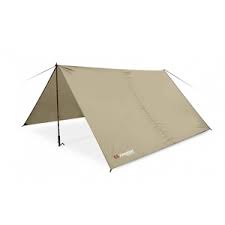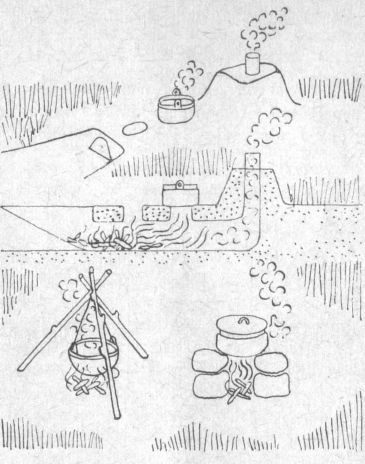
If we don't have the sheets, and we cannot afford to pay for a room with the host or at the hostel, or in a boating center, we resort to building a hut out of branches:
a) we prepare the material: tree twigs, straw, reed; we remember about nature protection and the regulations of the State Forests Directorate
b) we create the skeleton of the hut from pegs fixed in the ground, while the bars or upper joints are bound with a rope or thin twigs, grass, cane
c) twigs, straw, we put the reed on the ready skeleton with the tile system, hooking as closely as possible, taking care, that each layer is exactly overlapping, so that the roof does not leak.
We have already dealt with securing the accommodation, we still have to make a latrine and a pit for waste. The latrine (if the campsite is numerous) we place it away from the tents, at a distance of approx 100 m and on the leeward, digging a hole covered with bushes, bushes.
When leaving the parking place, carefully bury this hole. We do the same with the trash pit. When we are camping in a small team, it is enough to take the shovel with you every time you go to the "website” and bury all impurities immediately. We keep the campsite clean and tidy at all times, and by leaving them we eliminate all traces of our stay, that the heirs find them in the same condition as we are.
An indispensable part of our camping is the place for an evening bonfire. Selected carefully, should meet the following conditions:
a) be in the center of the camp, about 5-8 m from the tents
b) be located 50-100 m from the forest wall, as well as away from low-hanging tree branches (danger of fires)
c) when preparing a fire, we must protect against the transmission of fire, i.e.. dig it up (it is good to use a shovel to cut out the turf and put it aside, to cover the exposed ground again after the fire has gone out)
Tourists lighting a bonfire to blame:
a) have water and shovel at the ready (we put out the earth)
b) prepare dried branches (drought)
c) do not leave the camp during the campfire
d) when the fire goes out, they should be thoroughly covered with water and covered with soil
e) remember to protect nature and do not break branches, nor cut down trees
In the event of a longer stoppage, having sandy soil nearby (no silt), we can make a settler, thanks to which we will obtain purified - filtered water (keep in mind, that we can only drink this water after boiling it). We dig a well a few dozen cm deeper than the water table near the river or lake, her sides (50X50 cm) we cover the bottom with stones, and the water, which will seep there, it will be filtered through sandy or gravel soil and collected in our settler. If you have a bucket or a canvas bucket, we can put them in the sump.
When choosing a tent place, we do not forget about the place to set up the stove. If we have a spirit cooker, or gas or petrol, we choose a quiet place, sheltered from winds, flat, at a safe distance from tents and trees.
It is convenient and safe to locate the stove in a distance of 2-3 m from the tents in a dug recess in the ground. Be as careful as possible when lighting up and cooking:
a) do not refill the burners and tanks with liquid fuel during cooking
b) before refilling the fuel, put the cap on the burner, or shut off the gasoline supply (diesel)
c) we think, to avoid spilling fuel (we always refill the tanks with a funnel)
A lot of us, tourists, despite the fairly large amenities and facilities, what is the benefit of preparing meals on the cookers, he still uses primitive methods of cooking on a fire. This gives great satisfaction, however, it also has its drawbacks, such as a fire threat, constantly soiled pots and the specific taste of the dishes prepared, and constant vigilance when stoking the fire, which is tiring in the long run. However, there are enthusiasts among us - romantics, who only primitively spend their vacations and tramps. For them, the issue of cooking is very important. A simple camping kitchen can be assembled very quickly by placing two bricks upright in a safe place (slightly dug into the ground). Another simple kitchen is the so-called tripod, tied tightly with wire.

Prepare the hook for the pots from thick wire. If we stay camping for a few days, we can make a more solid kitchen.
It can be a grooved kitchen dug into the ground less than our pots. Cavity her, which acts as a hearth, makes it possible to put fuel on fire. It can also be a channel kitchen, made in the ground, with built-in brick or clay chimney.